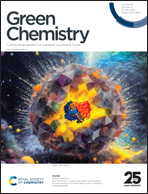A perspective on renewable production of amino acids from biomass through the chemocatalytic method
Abstract
Amino acids are an important class of fine chemicals that contain both amine groups and carboxyl groups, which are commonly used in food, medicine, and cosmetics. The conventional methods for amino acid synthesis, including the Strecker synthesis, enzymatic synthesis, and fermentation, suffer from highly toxic cyanides, non-renewable resources, enzyme instability, and high energy consumption. The development of environmentally friendly technologies for amino acid synthesis remains a formidable challenge. Biomass is the most abundant renewable resource on Earth and serves as an ideal candidate for the production of valuable chemicals and liquid fuels. This perspective highlights the potential of amino acid synthesis from biomass through the chemocatalytic method, including the catalytic conversion of biomass-derived oxygen-containing feedstocks to amino acids by introducing N-functional groups, as well as the catalytic synthesis of amino acids with chitin-derived nitrogen-containing feedstocks as starting materials. Finally, a perspective on critical challenges and future opportunities for amino acid synthesis through the chemocatalytic method is presented.

- This article is part of the themed collections: 2024 Green Chemistry Reviews and 2024 Green Chemistry Hot Articles


 Please wait while we load your content...
Please wait while we load your content...